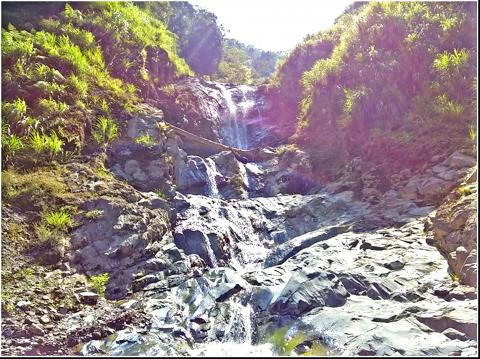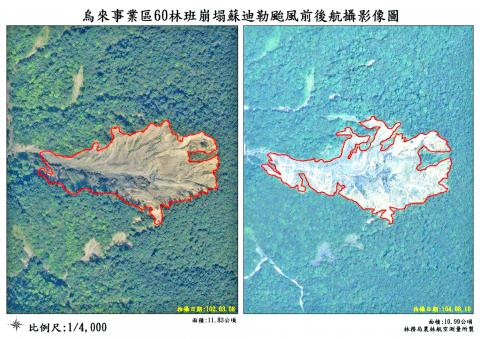The Forestry Bureau disputed a claim yesterday that inadequate conservation of a 1981 landslide site upstream of the Nanshih River (南勢溪) in New Taipei City’s Wulai District (烏來) caused murky tap water during Typhoon Soudelor.
The bureau on Wednesday released aerial images of the landslide site at the Dongjhakong River (東札孔溪) — about 28km upstream of where the Nanshih River and Peishih River (北勢溪) converge — taken on Monday after the typhoon, amid speculation that the site was the main contributor to the turbid water at Nanshih River, which is the major source of water supply for Taipei residents.
The collapsed area measured 10.99 hectares, which the bureau said was actually 0.84 hectares less than it was two years ago, suggesting well-managed conservation at the area.

Photo: CNA
The images also show that all the upstream stretches of the Nanshih River were muddy during Typhoon Soudelor and the Dongjhakong River was not the only contributor to the unprecedentedly high turbidity of water in the Nanshih River, the bureau said, adding that since the 1981 disaster, the bureau has undertaken the revegetation of the area.
The bureau’s move came after Taipei Mayor Ko Wen-je (柯文哲) said that poor conservation efforts at catchment areas around Feitsui Reservoir (翡翠水庫) in New Taipei City was the cause of the murky tap water during the typhoon.
A total of 56.89 hectares of land in Wulai collapsed after the typhoon: 32.5 hectares of which are national forests and the remaining 24.39 hectares of collapsed land are not national forests and not under its control, the bureau said.

Photo: CNA
Green Formosa Front standing director Lin Chang-mao (林長茂) said that the relatively large increase in collapsed areas that are not national forests — from 9.3 hectares in 2013 to 24.39 this year — was due to the illegal development of land reserved for Aborigines along the Nanshih River by hotspring resort operators who might not be of aboriginal descent.
“Land and hillsides along Nanshih River have long been occupied and abused by hotel operators, making the topsoil in the area loose which causes slides and collapses. That resulted in the highly turbid tap water seen in Taipei and New Taipei City and the damages done to Wulai during the typhoon,” Lin said
“The land [held by hoteliers at Wulai’s famous hot spring areas] is reserved for Aborigines and belongs to river reservation zone, but the New Taipei City government has negligently allowed illegal hotel operators to use the land without removing illegal structures. It is a non-exercise of authority by the government,” he said.
According to the New Taipei City’s Tourism and Travel Department, there are 14 legal hotels and 26 “non-legal” hotels at Wulai. They are not legal because the hotels were established before the land was rezoned to a reservation area, the department said.
New Taipei City Mayor Eric Chu (朱立倫) yesterday said that the city government has not issued any hotel operating permits in Wulai over the past 10 years.
In response, Lin said that the Regulations on Development and Management of the Lands Reserved for Indigenous People (原住民保留地開發管理辦法) were promulgated in 1990, but there have been hotels constructed in Wulai since then.
In reponse to Forest Bureau’s denial, Ko yesterday said: “I do not care whether it was caused by [Dongjhakong River]; you only have to tell me why the Nanshih River was muddy.”
He said he did not mean to blame anybody, but hoped that the problem could be solved not be exchanging barbs but by action.
Additional reporting by Alison Hsiao

An essay competition jointly organized by a local writing society and a publisher affiliated with the Chinese Communist Party (CCP) might have contravened the Act Governing Relations Between the People of the Taiwan Area and the Mainland Area (臺灣地區與大陸地區人民關係條例), the Mainland Affairs Council (MAC) said on Thursday. “In this case, the partner organization is clearly an agency under the CCP’s Fujian Provincial Committee,” MAC Deputy Minister and spokesperson Liang Wen-chieh (梁文傑) said at a news briefing in Taipei. “It also involves bringing Taiwanese students to China with all-expenses-paid arrangements to attend award ceremonies and camps,” Liang said. Those two “characteristics” are typically sufficient

The brilliant blue waters, thick foliage and bucolic atmosphere on this seemingly idyllic archipelago deep in the Pacific Ocean belie the key role it now plays in a titanic geopolitical struggle. Palau is again on the front line as China, and the US and its allies prepare their forces in an intensifying contest for control over the Asia-Pacific region. The democratic nation of just 17,000 people hosts US-controlled airstrips and soon-to-be-completed radar installations that the US military describes as “critical” to monitoring vast swathes of water and airspace. It is also a key piece of the second island chain, a string of

A magnitude 5.9 earthquake that struck about 33km off the coast of Hualien City was the "main shock" in a series of quakes in the area, with aftershocks expected over the next three days, the Central Weather Administration (CWA) said yesterday. Prior to the magnitude 5.9 quake shaking most of Taiwan at 6:53pm yesterday, six other earthquakes stronger than a magnitude of 4, starting with a magnitude 5.5 quake at 6:09pm, occurred in the area. CWA Seismological Center Director Wu Chien-fu (吳健富) confirmed that the quakes were all part of the same series and that the magnitude 5.5 temblor was

The Central Weather Administration has issued a heat alert for southeastern Taiwan, warning of temperatures as high as 36°C today, while alerting some coastal areas of strong winds later in the day. Kaohsiung’s Neimen District (內門) and Pingtung County’s Neipu Township (內埔) are under an orange heat alert, which warns of temperatures as high as 36°C for three consecutive days, the CWA said, citing southwest winds. The heat would also extend to Tainan’s Nansi (楠西) and Yujing (玉井) districts, as well as Pingtung’s Gaoshu (高樹), Yanpu (鹽埔) and Majia (瑪家) townships, it said, forecasting highs of up to 36°C in those areas